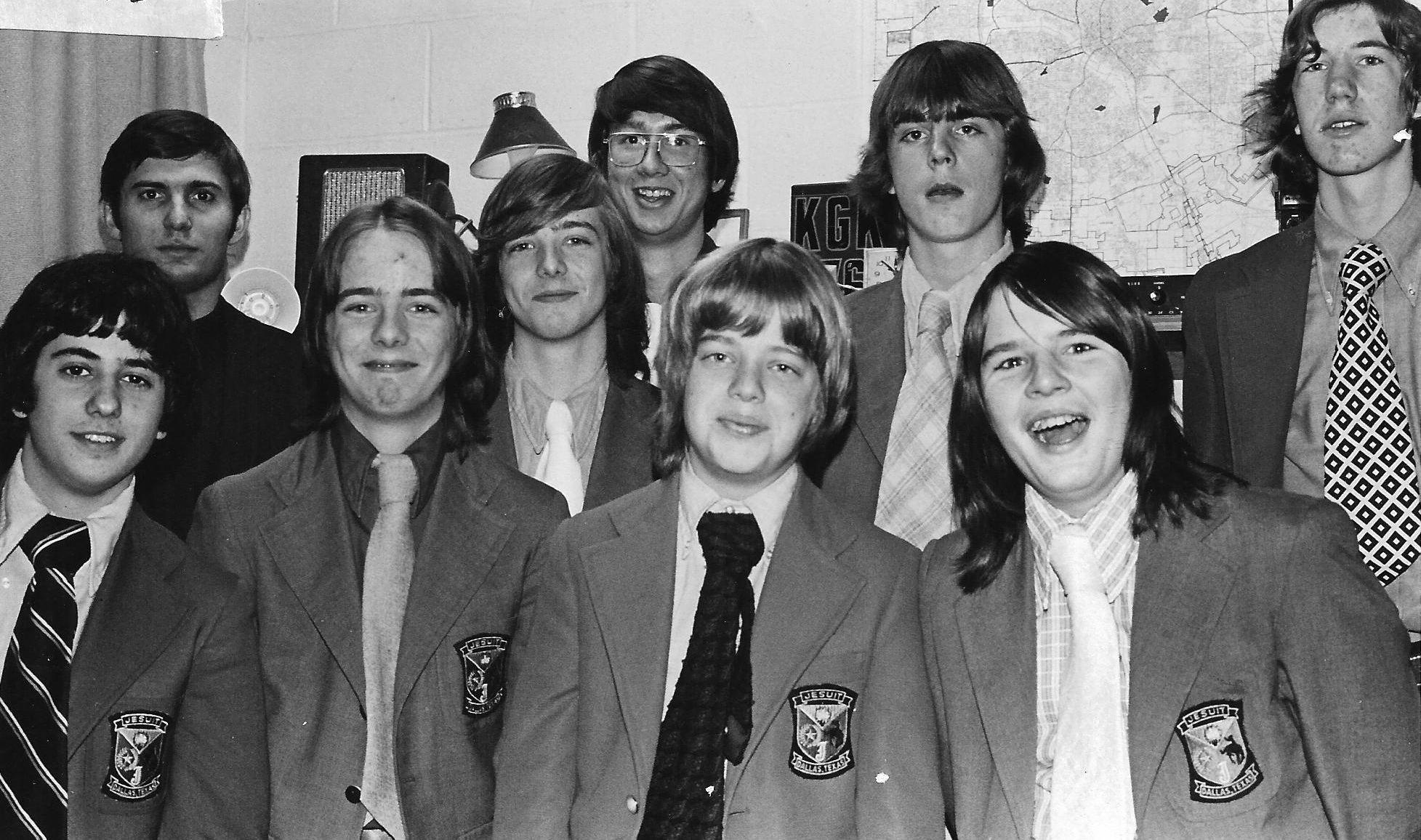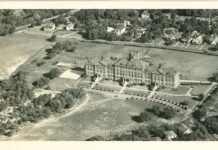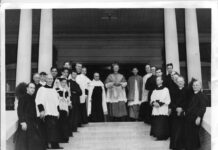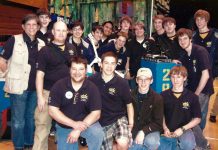The 1942 Mothers’ Club scrapbook includes a school newspaper article about the beginnings of the Radio Club which states, “The initial lecture of a series of experiments and lectures designed to equip seniors and all members of the student body who have reached their eighteenth birthday with the fundamentals of radio and other standard army communications was given . . . at the Science Academy.” The Academy sponsored the course taught by parent Mr. Spetter who had taught in an Army Camp.
In 1950 Fr. Julius May, S. J., an avid Ham radio operator, set up his station on the 4th floor of the school building. He hoped to start an amateur ham club at Jesuit for the students (The Roundup April 1950).
The Last Roundup 1954 reported that a Radio Club had been established in February 1954 under the supervision of Mr. W. E. Underhill, S. J. (The November 1955 Roundup states the club’s founding as 1953.) The club has “a twofold function: first, instruction of the members in the fields of radio and electronics, and second, supervision of each student’s constructing his own set.” The club conducted both code and theory classes.
The club instructed its members “in the fundamentals—Morse code, necessary because until a special license is obtained, all conversation must be in Morse and the numerous intricacies of the radio equipment.” The club had its own station, “built entirely by its members, with which contact has been established with other ‘ham’ in various parts of the country.”
All students had obtained a novice license at minimum. The November 1954 Roundup reported that, per the club’s constitution, a member remained probationary until this was accomplished. The members toured “the transmitting section of the WFAA television station” and planned additional trips. The club planned to issue information bulletins to the students, to “rejuvena[te]” a tesla coil belonging to Sam Lomomaco, and to construct a “similar tesla coil on a larger scale.” The group planned a demonstration for the student body at the third quarter assembly. “Another project for the future will be the repairing of the physics lab’s Van de Grant generator.”
In November 1955 The Roundup reports that the increasing membership bought textbooks and planned to purchase educational electronic kits. A second project proposed accepting the invitation to visit a Sylvania plant in Oklahoma. Finally, the group planned to make a “simple, yet useful, electronic computer.”
The 1955 Last Roundup reported that the club “has added to their 60 watt transmitter and other instruments, a donated 300 watt transmitter and a repaired 12 watt transmitter. Also, besides the stations which the members themselves have assembled, the JRC has constructed a Tesla coil, a very high-power, high-frequency transmitter used for demonstration purposes.”
The 1956 Last Roundup reports the club had assembled “electronic equipment for Fr. May’s science lab. . . . The organization received and repaired three television sets for standard use. . . . A dilapidated tape recorder was expertly reconditioned and sold. [In addition}, an all-purpose power supply was made by the members for their use. And now they are working on a ‘solar battery,’ (a device which uses the sun as a source of electricity). They intend to power a transistor radio when the battery is perfected.”
The January 1957 Roundup reports that the club, under the leadership of Mr. W. Wolcott, S. J., sacrificed “their time on Saturday and after school . . . to increase the efficiency of the school and to ease the work of the teachers and students.” They built the intercom system for the theater, put in new speakers for Father Kammer’s and Father Rivoire’s offices, and repaired the school’s public address system.
In addition, the group held a picnic honoring Fr. May, S. J. and held their annual Christmas party in the gym. At the party, “the members watched television on the Club’s experimental set . . . [and] went down to the Radio Room and made two contacts on the transmitter with people in Ohio.”
One of the important accomplishments of the club was the “code classes at the beginning of the year, held so that the candidates, becoming proficient in the use of Morse code, could obtain their amateur licenses.”
The January 1957 Roundup describes the process of meeting FCC regulations for various licenses and invites students to join the club and move through the process.
The December 20, 1957 Roundup reports that the Radio Club is now a major school organization and “able to fulfill its purpose— to give its members an intelligent understanding of radio electronics in general, and to stir their interests so they will either take up electronics in college or will keep it as a hobby.” Fr. Allen and Mr. Selgas directed the club and set the club to work repairing radios. “Besides greatly helping the candidates increase their knowledge of the radio, it proves to be a small income which helps to offset the cost of new testing equipment, etc.” All choose their own assignments ranging from new transistor radios to large amplifiers. “Some are even trying to construct such things as color organs, instruments which react to the frequency of sound by flashing a certain light. . . . “Transmitting . . . always has been an important part of the Radio Club. Candidates are taught the Morse code and some basic electronics so that they can receive their novice license and get on the air as soon as possible.” The club continued to tour electronics plants such as the Collins Radio Company.
The April 16, 1957 Roundup reports that the Radio Club installed an intercom system for the Jesuit residence. They installed loudspeakers “at each entrance to the faculty residence.” The Jesuits “who have rooms on the second and third floors . . . saves them countless steps” up and down the stairs. The club strung five hundred feet of wire and connected two master and six remote stations. This “required drilling holes through two floors, through walls, brick, concrete, and assorted other impediments.”
The 1957 Roundup reports that the Radio Club purchased two klystrons and experimented “in the microwave region; and with the use of a new 600 watt transmitter club members have been broadcasting in the amateur VHF bands.”
The 1958 Last Roundup notes that the “purpose of the Jesuit Radio Club is to educate its members in the theory of electronics and in the operation of electronic instruments so that they may have many hours of enjoyment while giving service to their fellowmen and greater honor and glory to God. . . . The club has a large amount of equipment worth nearly $2,000. It ranges from a 12 watt transmitter to a 1000 watt transmitter to an extensive library including a complete set of electronic magazines dating back over thirty years. In keeping with the service to their fellowmen the Club has installed and maintained much of the school’s electrical equipment. These services range from the installation of lights and intercoms to maintenance of the school’s 185 watt amplifier and setting it up for most of the school functions. Some members have been a great help to Father May’s physics class and his Electronics Seminar. In May the Club participated in the Dallas Student Crafts Fair of over 4500 exhibits. The Club’s Tesla Coil won a First Award and an Outstanding Award.”
No information is reported on the Radio Club in documents for many years. However, interestingly, the February 21, 1975 Roundup reported the Radio Club as a new club. The seven member Radio Club was moderated by Mr. Ed Gross, S. J. and had eight radios. “The club has three members of Dallas County R. E. A. C. T. (Radio Emergency Associated Citizens’ Teams) servicing motorists, reporting and relaying accidents and other local emergencies to the police or other authorities, and monitoring the emergency channel. . . . The present Radio Club is different from its counterpart of some years back. The old Radio Club was in Ham operations, whereas the present club is into C. B. (Citizens’ Band) activities. Also the club has had a new antenna installed, and has shifted its accommodations to the opposite side of the school.”
No further coverage of the Radio Club continued.




